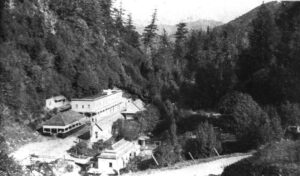As a Kelley House docent researching a book on the Orr Hot Springs area, I have amassed more information than I could ever possibly use in what I plan to be a small publication on the subject. While the who, what, when, where, why and how facts get arranged into chronological order, it’s the odd, poorly documented tidbits of information that keep distracting me.

Postcard of a general view of Orr Hot Springs west of Ukiah showing the lodge and grounds, circa 1908.
For those who may not know of this place, Orr Hot Springs was a popular resort and stage station on the road between Ukiah and Mendocino, along the main fork of Big River, which here flows in a deep, wide canyon. A hotel and cottages furnished accommodations for guests, and tents were erected during the summer when needed. Five springs rise near the hotel, ranging in temperature from about 70° to 104°. One of the springs rises in a small swimming plunge, and the others supplied tub and plunge baths. The resort is still in existence, although not the same place as it was in the late 1800s and twentieth century.
How about Orr Springs and methane gas production? Somewhere, sometime long ago in my mental inventory I heard or read that the resort collected the gases bubbling up with the spring water. In a 1915 photo I recently found, there is a six-foot high and round cement dome attached to the side of the outdoor plunge pool. Another comment I have buried in my research materials said the resort collected enough methane to heat a mangle, which is a commercial ironing machine.
Who taught the owners of the springs how to capture natural gas and use it to run machinery? These were not highly educated folks, although Samuel Orr, the founder, did serve as Mendocino County Treasurer from 1865 to1867. They were fourteen miles west of Ukiah over Low Gap Road. Did a guest tell them about the possibilities of natural gas use? Did they create their own equipment? Did they ever use the gas for lighting the resort?
A link to another history mystery may be connected to methane. Under a current structure is a cast iron relic stamped “Cyclops Iron Works San Francisco.” It was housed in the 1938 hotel that burned down, and it probably fell through the floor during the fire. Cyclops Iron Works produced commercial refrigeration equipment units that possibly had their own generators. How was this unit powered? Could it have been the collected methane gas? While old photos of the resort show the hotels, guests and amenities, the nuts-and-bolts side of resort operation was seldom photographed.
Then there’s the 1901 Ukiah newspaper display advertisement proclaiming “Oil!-A New Enterprise In Mendocino County.” Gas was issuing from rock crevices and if you put a match to it a steady flame burned. There was oily scum on rocks and UC Berkeley Professor Le Conte said these were all high-grade oil indicators. The owners of the springs were looking for $200,000 in investments at $1.00 a share to begin drilling an oil well. “This investment opportunity could not be surpassed!” The offering must have been a total flop as nary a word was ever seen in print again about this scheme.
How about a proposal to put a railroad in the Orr Springs area? In a 1935 Ukiah newspaper the headline read, “Narrow Gauge Railroad Will Run Mile And A Half In The Hills.” The tracks would run from the Whipple Mill, west of the resort area, south to the county road. It was impossible to haul lumber downhill from the mill during severe weather. The railroad would traverse the side of the canyon. To see this proposal in the midst of the Great Depression was unusual, but the mill claimed a payroll of $5,000 a month being paid out and wanted to keep everyone fully employed in winter. Again, nothing was ever seen again in print about this proposal.
A history mystery I came closer to solving was a photo taken at the resort of an unidentified Chinese man dressed like a cook holding a white child. Orr Hot Springs employed Chinese cooks into the mid-20th century. It took delving into census records to find out who was living in this “household.” The Orr and Weger families managed the resort and yes, they were listed, but also everyone who boarded there. These included cooks, hostlers, carpenters, housekeepers, laborers and others. In the 1910 census, Lim Chin, age 45, a cook, is listed living there. In the 1940 census Jim Sook was a cook, along with a man named Dea, listed as Chinese.
So, part of my writing a SHORT history of a place is focusing on the people and eliminating tidbits…so methane gas and Cyclops engines and a railroad a few miles away won’t make it into the book, but the Chinese cooks will.
If any readers have personal knowledge of Orr Hot Springs before 1970, or photographs, and wish to share information, contact me at [email protected]. Expect a small book of Orr Hot Springs history next year.
Katy Tahja is a long-standing Kelley House volunteer and docent who often contributes her research and writing skills to this column. She has published many local history books, which can be purchased at the Museum, at our online store, and at local bookstores.